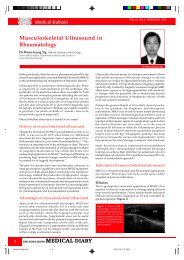MEDICAL DIARY - The Federation of Medical Societies of Hong Kong
MEDICAL DIARY - The Federation of Medical Societies of Hong Kong
MEDICAL DIARY - The Federation of Medical Societies of Hong Kong
You also want an ePaper? Increase the reach of your titles
YUMPU automatically turns print PDFs into web optimized ePapers that Google loves.
VOL.11 VOL.14 NO.5 NO.1 MAY JANUARY 2006 2009<br />
Atrial Fibrillation Catheter Ablation<br />
Dr. Yui-chi So<br />
MRCP (UK) MRCP (Ireland) FHKCP FHKAM<br />
Specialist in Cardiology<br />
Introduction<br />
In China Mainland, a cross -sectional survey <strong>of</strong> AF<br />
conducted from 2005 to 2006 including 19,368<br />
participants (8,636 men, 10732 women) aged >= 35 years<br />
showed that the prevalence <strong>of</strong> AF in Chinese adults was<br />
0.73% (0.74 % in men and 0.72 % in women). <strong>The</strong> AF<br />
incidence was 0.43% in men and 0.44 % in women with<br />
age = 60 years old. AF prevalence was<br />
estimated to be 0.41 % around 5.3 million patients in the<br />
Mainland.<br />
In the United States, AF prevalence was estimated to be<br />
2.3 million. Between 1980 and 1999, AF hospitalisations<br />
increased 80 % for patients aged 45-65 and doubled for<br />
patients 65 yrs or older. <strong>The</strong> ageing <strong>of</strong> the population<br />
alone is expected to raise the number <strong>of</strong> AF from 2<br />
million in 1995 to more than 3 million by 2020 and 5.6<br />
million by 2050.<br />
Framingham data showed that at age 40, there is a risk<br />
<strong>of</strong> 1/4 to develop AF. 1.3 % <strong>of</strong> individuals in the elderly<br />
population in <strong>Hong</strong> <strong>Kong</strong> had AF.<br />
Paroxysmal AF<br />
Defined as an AF episode which spontaneously<br />
terminates within 7 days.<br />
Persistent AF<br />
Defined as an AF episode which lasts for more than 7<br />
days or requires cardioversion.<br />
Permanet AF<br />
An AF episode which fails to terminate with<br />
cardioversion or terminates and relapses within 24 hours.<br />
Epidemiology<br />
In China, the percentage <strong>of</strong> AF <strong>of</strong> first diagnosed were<br />
30.9 %; paroxysmal 33 %, persistent 7.2 % and<br />
permanent 28.9 % respectively.<br />
<strong>The</strong> recurrence rate <strong>of</strong> AF is around 49-90 %. In the<br />
Stroke Prevention trial, the independent predictors <strong>of</strong><br />
recurrence were left atrial enlargement and a history <strong>of</strong><br />
Foci <strong>of</strong> AF<br />
<strong>Medical</strong> Bulletin<br />
myocardial infarction. Around 18-33 % <strong>of</strong> patients will<br />
develop permanent AF. Old age and AF at presentation<br />
predicted transition to permanent AF.<br />
However, many PAF episodes are asymptomatic. A<br />
transtelephonic ECG monitor found that asymptomatic<br />
PAF was 12 x more frequent than symptomatic ones.<br />
Aetiologies<br />
1. Idiopathic ( lone AF)<br />
2. Increased LA pressure<br />
3. Ischaemia<br />
4. Inflammatory<br />
5. Age related ( fibrosis and amyloid)<br />
6. Alcohol<br />
7. Increased sympathetic activity such as thyrotoxicosis,<br />
anxiety, exercise<br />
8. Increased parasympathetic activity such as during<br />
sleep<br />
9. Congenital heart disease such as ASD<br />
10. Neurogenic such as Subarachnoid haemorrhage<br />
11. Familial<br />
12. Sick sinus syndrome<br />
a) Pulmonary vein(PV) ectopic beat for AF<br />
initiation:<br />
<strong>The</strong>re are myocardial sleeves in the embryonic<br />
development <strong>of</strong> pulmonary veins which give rise to<br />
abnormal automaticity. Many evidences show that<br />
there is dilation <strong>of</strong> PV ostia in patients with AF. <strong>The</strong>se<br />
demonstrate that haemodynamic factors and stretch<br />
mechanisms may account for PV ectopic beats.<br />
Haissaguerre first studied the mechanism <strong>of</strong><br />
spontaneous onset <strong>of</strong> AF was due to PV ectopic triggers.<br />
Investigators also demonstrated that PV activity may<br />
also have a role in maintaining AF too.<br />
PV ablation<br />
Dr. Yui-chi So<br />
1. Focal ablation- <strong>The</strong> PV potential which initiates AF<br />
had high frequency spikes. <strong>The</strong>refore, it is logical to<br />
directly ablate the PV potential. However, the<br />
recurrence rate is high even after ablating the PV<br />
potential at OT site. Moreover, it will cause PV stenosis.<br />
Inconsistent inducibility, multiple and new foci <strong>of</strong><br />
triggers are among the failure reasons for AF initiation.<br />
27

















